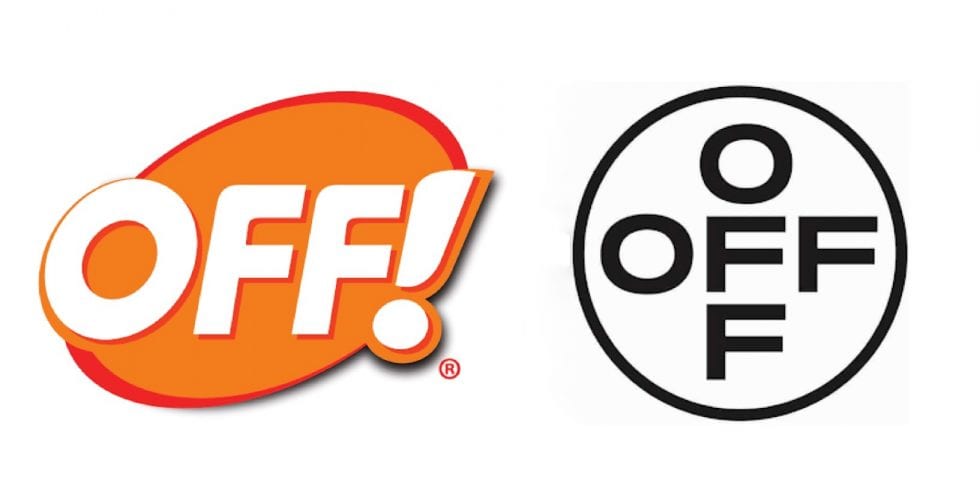Off-White and S.C. Johnson appear to have put their branding differences aside for the time being, with the American multinational consumer packaged goods and chemicals company withdrawing its opposition to one of Off-White’s pending trademark applications for registration. On September 15, Racine, Wisconsin-headquartered S.C. Johnson filed a motion with the U.S. Patent and Trademark Office’s Trademark Trial and Appeal Board to withdraw its formal fight to block the registration of an Off-White trademark that consists of “a circle containing the term ‘OFF’ twice, where each term intersects the other at the letter ‘F’ as in the shape of a cross.”
The parties’ clash started not long after Off-White filed an application for registration for the circular mark for use on jewelry, handbags, and fragrances, among other things, in January 2019. (Off-White subsequently amended its application to remove Class 3, including fragrances.) In response, S.C. Johnson lodged an opposition, arguing in October 2019 that Off-White should be blocked from registering the “OFF Cross Design mark” because it is a bit too similar to the marks it already uses in connection with its 63-year old Off! insect repellant brand.
Due to its “longstanding and continuous use of its OFF! trademarks,” S.C. Johnson claimed that “the relevant consuming public recognizes the OFF! trademarks as identifying [S.C. Johnson] as the source of the goods offered under the OFF! trademarks” – not Off-White. This is particularly true, the company claimed, due to the fact that it “has expended considerable time, money, and effort advertising and promoting its OFF! trademarks throughout the U.S.,” which has resulted in “enormous recognition for and tremendous goodwill in the OFF! trademarks.”
While the two companies do not exactly trade in the same types of goods, S.C. Johnson’s OFF! brand sells various repellant products, whereas Off-White primarily sells garments and accessories, S.C. Johnson argued that consumers that see Off-White’s OFF Cross Design mark will, nonetheless, “believe that it is merely a stylization of S.C. Johnson’s OFF! trademarks.” This is due in part to the fact that “the dominant elements [of the two parties’ trademarks] and the emphasis of the marks are identical,” the company alleged. As a result, “The commercial impression conveyed by [Off-White’s] OFF Cross Design mark and S.C. Johnson’s OFF! trademarks is the same.”
More than that, S.C. Johnson claimed that its products and those of Off-White are not only “likely to be marketed and sold to the same consumers and move in the same channels of trade,” but … Off-White’s goods “are in the likely zone of expansion for goods sold by S.C. Johnson under the OFF! marks,” thereby, leading to further potential for confusion.

(As I noted in a previous article, here, S.C. Johnson was essentially seeking to broaden the protection that it currently enjoys from its rights in OFF! as used on the goods/services that it actually offers to ones that it argues are in the “natural scope” of potential expansion. This theory “contemplates that consumers understand a connection between various goods or services, and that a business that offers some items in connection with a brand is likely to be connected with the offering of similar goods or service under that brand,” says Gordon Feinblatt LLC’s Ned Himmelrich.
The doctrine, itself, is a interesting/relevant one particularly in light of the ever-expanding range of products/services offered up by consumer goods companies, fashion brands, included. Hermès’ new-ish cosmetics collection, Gucci’s home decor offerings, and Rosie Assoulin’s natural wine label are a few examples of this, as are the products that fall under the umbrella of Abloh’s almost-endless line up of collaborations – from tie-ups with Evian and Ikea to Mercedes and Moet. The core issue in such an argument is, of course, the extent of what additional goods/services fall within the natural zone of expansion.)
Still yet, because “a significant percentage of the relevant consuming public recognizes OFF! as an indicator of source, as shown by the volume of sales of the goods sold under the mark, [S.C. Johnson’s] use of the mark in commerce since the 1950s, and the advertising resources used to promote it,” those same consumers are likely to be confused as to whether there is a connection between products bearing its mark and those bearing Off-White’s Cross Design mark.
Faced with S.C. Johnson’s opposition, Off-White filed its response in March 2020, denying an array of the allegations made by the consumer goods conglomerate, and asserting a handful of defenses. Among other things, counsel for Off-White argued that its use of the Cross Design mark “is not likely to cause confusion” with S.C. Johnson’s marks, and that its goods are not “the same as or similar to [S.C. Johnson’s] goods/services and thus, are not likely to cause confusion with [S.C. Johnson’s] goods/services.”
Fast forward to September and S.C. Johnson said that it “moves to withdraw its opposition to the mark,” albeit without prejudice, meaning that it may take similar action again in the future. With the S.C. Johnson opposition out of the way, Off-White’s circular mark can now proceed to the rest of the registration process.
Off-White & The Bigger Picture
S.C. Johnson is not alone is seeking to stand in the way of others’ attempts to gain registrations for potentially confusing marks. In furtherance of its own aim to shut down trademark applications that it deems to be potentially harmful, Off-White has pushed back against an array of third-party marks, such as Off-Book, OFFPANDA, Off-Logic, Dark Whyte, Offstreet, and Offsky for use on various types of apparel and accessories, as well as others, such as OFF-BOUNDS for use in connection with entertainment services, “namely, displaying a series of films.” (If Off-White’s athleisure collection, OFF ACTIVE, and corresponding trademark application for the mark are any indication, it may opt to similarly brand its various category extensions in this same way, hence, the attempts to prevent others from using “Off” as a prefix of sorts.)
This comes in conjunction with Off-White’s enduring quest to amass trademark rights in/registrations for various word marks and graphics, as well as things like red zip ties. The brand has filed upwards of 80 trademark applications for registrations in the U.S., alone, over the past couple of years, and more with other international trademark offices.
Off-White appears to be notably more aggressive than many other similarly-situated companies when it comes to its trademarks (Supreme, for instance, waited over a decade to begin aggressively amassing registrations and policing many unauthorized uses). However, its practice of emphasizing the role/value of branding – and the emphasis placed on branding by other streetwear/skatewear brands – mirrors the model successfully utilized by luxury brands in that at the core of their model is the practice of leveraging intellectual property, namely, trademarks, and generating revenue thanks, in many cases, to striking markups that those trademarks enable them to enjoy. In other words, luxury brands and many streetwear brands, alike, are more primarily selling trademarks (i.e., brand names, logos, etc.) and the goodwill embodied in those marks than they are selling individual garments and/or accessories. And this is the result of the consumer recognition of those marks and the corresponding demand for them as indicators of source, of course, but also indicators of social status or belonging and/or as an indicator of the wearer being “in the know.”
And back on the opposition front, it is interesting (although, probably not surprising given the goods/services at play) that Bayer did not take action against Off-White as a result of its own circular logo, which very clearly served as the inspiration for Off-White’s mark. Chances are, if Off-White is on Bayer’s radar, counsel for the German multinational pharmaceutical and agricultural behemoth may have opted not to initiate an opposition after potentially determining that the two parties’ goods/services are simply too different to cause confusion among consumers. That does not mean that Bayer – whose brands range from Claritin, Windex and Ziplock to Roundup Ready 2 Xtend™ soybeans and TruFlex™ Canola (eww) – cannot take trademark infringement action against Off-White in the future, but I, for one, do not see that happening any time soon.














